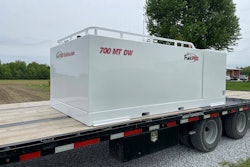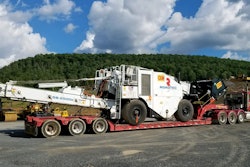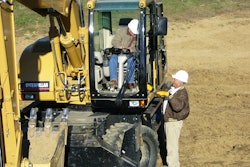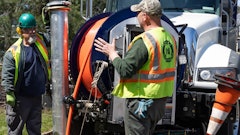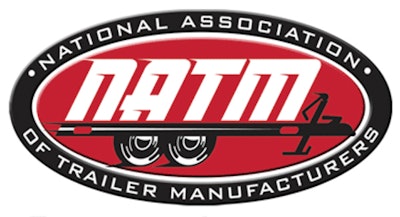
When you think about the equipment you own, chances are your mind first goes to your big money-maker, that tool that's always on rent and which has brought significant return on investment. Maybe it's a piece of big iron out in the yard, possibly it's that concrete breaker you've had for 20 years but keeps on running. Now consider this: How much time do you spend thinking about your trailer fleet? These unsung heroes don't cost a lot, they don't require a tremendous amount of maintenance, and yet, without them, a lot of your equipment would remain right where it is – in your yard.
Now that you're thinking about your trailers, here's another question to ponder: Are yours up to snuff? Do they meet all safety requirements? The answers to these questions are important because they could affect your eligibility for insurance, not to mention the rates you pay.
Clint Lancaster, technical director of the National Association of Trailer Manufacturers (NATM) spoke to us recently about various initiatives the organization is working on to improve trailer safety for everyone.
Lights and brakes
Chief among the safety concerns associated with trailers are lighting and brakes. Currently, the laws and regulations regarding lights and brakes are ambiguous at best, but the NATM is working to change that.
"The biggest issue is proper lighting," Lancaster says. "Not only the requirement for lights in specific locations on the trailer, depending on size and weight, but also, that the lights are actually functioning with the proper photo metrics. There's a lot of lighting that's manufactured off shore that doesn't meet the minimum brightness requirements."
Brakes are also a huge issue. "There are two different governing bodies where brakes are concerned," Lancaster explains. "The federal government regulates braking on commercial vehicles. They're required to have brakes on all axles, or all wheels, for anything with a GVWR over 3,000 pounds."
Consumer use of trailers, however, is regulated by individual states. "They're all over the board,” Lancaster says. “There are several states that don't have any brake laws -- you can build a 10,000-pound trailer and not have any brakes on it, if it's for consumer use. Or, you could go to New Jersey and be required to have brakes on a trailer that's 1,500-pounds GVWR.”
He continues, “Of the 50 states, 26 of them have adopted the 3,000-pound GVWR brake requirement. We'd like to see that be the standard for everyone."
One of the serious problems with this inconsistency is that in states like Texas, where the laws don't require brakes until the front axle is over 4,500-pounds GVWR, trailers can be manufactured and then shipped to other states where the brake laws are more strict. In other words, trailers that are legal in Texas might not legal in other states.
Are you liable?
If the trailer you bought from your supplier does not meet your state's braking requirements or the Federal Motor Vehicle Safety Standards for adequate lighting, are you responsible? Unfortunately, there is no clear answer.
Lancaster says when renting for commercial applications, rental businesses are only liable if an accident occurs. If the motor carrier (your renter) is pulled over by police, either for a traffic violation or because of a lack of adequate lighting, he or she will be issued a citation. On the other hand, if a trailer is rented to a homeowner and he or she is pulled over, the rental center is responsible.
What happens then? Depending on the situation, a rental center could see a significant increase in insurance premiums, or worse, be dropped by their insurance carrier. There is also the expense and hassle of having to retrofit trailers with the proper lights and brakes before sending them out on the road again.
To avoid these consequences, Lancaster suggests rental companies familiarize themselves with the laws in their state and do the best they can to ensure their trailers meet Federal Motor Vehicle Safety Standards. Fortunately, for its part, the NATM is doing its best to achieve some consistency in trailer safety and manufacturing.
Required compliance
One of the NATM’s current efforts, Lancaster said, is working to require its members (trailer manufacturers) to verify compliance with Federal Motor Vehicle Safety Standards.
"We’ve had a compliance program since 2002,” Lancaster says. “It started as a voluntary program. Members could request an inspection, or an audit, to make sure they're meeting all the Federal Motor Vehicle Safety requirements that they're required to do by law.”
He adds, “At last year's NATM annual meeting, the membership voted to make compliance verification a requirement for membership.”
This is important because the trailer manufacturing industry has very low barriers to entry. Often, individuals with a welding background will begin to make trailers, but they don't understand the complexity of the government regulations they have to abide by. The compliance program was designed in response to this need among trailer makers to ensure they meet all safety requirements.
"[The voluntary compliance program] provided a chance for members to have someone come out to their plant, actually take a look at their trailers, make sure they have all the correct lighting in the right places, brakes, safety chains, proper couplers… there’s a three-page checklist," Lancaster explains. "Any discrepancies they had they would need to correct, then show us proof they were corrected, and then we would certify them. Every two years, we would go back and do another recertification."
Companies that are certified are allowed to apply the NATM compliance decal on their trailers, letting consumers know their trailers are built to Federal Motor Vehicle Safety Standards.
"We've really been trying to get people to recognize that compliance decal so fleet managers and rental stores have some assurance that somebody -- a third-party entity -- has actually gone to that plant, looked at their operation, looked at their product, and ensured that they at least meet their minimum manufacturing requirements,” Lancaster explains.
At the beginning of this year, compliance verification officially became a requirement for NATM membership. To put this in perspective, the NATM has approximately 400 members. Lancaster says about 30 percent of all trailer manufacturers are members of the NATM, and those companies produce about 80 percent of the trailers in use today.
Brake standard coming soon?
In addition to solving the problem of trailer safety inconsistency by requiring standards compliance of its members, the NATM is also approaching the issue from the other side.
“Last year, we brought together three major associations -- NATM, the Recreation Vehicle Industry Association (RVIA) and National Marine Manufacturers Association (NMMA) -- and created an industry work group for standardized brake performance,” Lancaster says. “We’re trying to develop an standard for brake performance that we can accept as an industry.”
Lancaster says the group is close to finishing its draft of the standard, which will then go to SAE to be fully developed. “Once we have that standard, then we can go back to members and say, ‘This is the way you should do it.’ It won't be the law, but it will be the first step.”
If all goes as planned, Lancaster says there could be an official braking standard by the end of 2012, which could then be implemented as early as the beginning of 2013.
“Once implemented, it's still a voluntary standard,” he says. “But we intend to put this brake standard into our compliance inspections.”
Take responsibility for equipment safety
The NATM is working hard to ensure the safety of trailers on the road today and the initiatives the association is working on promise to significantly further that goal. In the meantime, it’s up to equipment owners like you to be aware of the current safety standards and do what you can to provide the safest equipment possible to your customers, such as only buying trailers that have the compliance decal on them. Doing so not only benefits the general public, including your customers, but it helps to protect your business from liability and needless expense.




